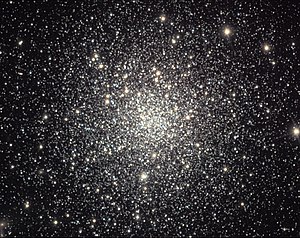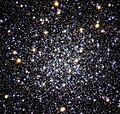astro.wikisort.org - Galaxy
Messier 12 or M 12 (also designated NGC 6218) is a globular cluster in the constellation of Ophiuchus. It was discovered by the French astronomer Charles Messier on May 30, 1764, who described it as a "nebula without stars".[8] In dark conditions this cluster can be faintly seen with a pair of binoculars. Resolving the stellar components requires a telescope with an aperture of 8 in (20 cm) or greater.[9] In a 10 in (25 cm) scope, the granular core shows a diameter of 3′ (arcminutes) surrounded by a 10′ halo of stars.[8]
| Messier 12 | |
|---|---|
 Globular cluster Messier 12 in Ophiuchus | |
| Observation data (J2000 epoch) | |
| Class | IX[1] |
| Constellation | Ophiuchus |
| Right ascension | 16h 47m 14.18s[2] |
| Declination | –01° 56′ 54.7″[2] |
| Distance | 16.44 ± 0.16 kly (5.04 ± 0.05 kpc)[3] |
| Apparent magnitude (V) | 6.7[4] |
| Apparent dimensions (V) | 16′.0 |
| Physical characteristics | |
| Mass | 8.7×104[5] M☉ |
| Radius | 37.2 ly[NB 1] |
| Metallicity | = –1.14[6] dex |
| Estimated age | 13.8 ± 1.1 Gyr[3] |
| Other designations | NGC 6218[7] |
Roughly 3°[9] northwest from the cluster M10 and 5.6° east southeast from star Lambda Ophiuchi, M12 is about 16,400 light-years (5,000 parsecs)[3] from Earth and has a spatial diameter of about 75 light-years. The brightest stars of M12 are of 12th magnitude. With a Shapley-Sawyer rating of IX,[1] it is rather loosely packed for a globular and was once thought to be a tightly concentrated open cluster. Thirteen variable stars have been recorded in this cluster. M12 is approaching us at a velocity of 16 km/s.[10]
A study published in 2006 concluded that this cluster has an unusually low number of low-mass stars. The authors surmise that they were stripped from the cluster by passage through the relatively matter-rich plane of the Milky Way.[11]
- Messier 12 core by HST
- The Central Part of Messier 12. Credit: ESO
 Map showing the location of M12
Map showing the location of M12
See also
- List of Messier objects
Notes
- distance × sin( diameter_angle / 2 ) = 37.2 ly radius
References
- Shapley, Harlow; Sawyer, Helen B. (August 1927), "A Classification of Globular Clusters", Harvard College Observatory Bulletin, 849 (849): 11–14, Bibcode:1927BHarO.849...11S.
- Goldsbury, Ryan; et al. (December 2010), "The ACS Survey of Galactic Globular Clusters. X. New Determinations of Centers for 65 Clusters", The Astronomical Journal, 140 (6): 1830–1837, arXiv:1008.2755, Bibcode:2010AJ....140.1830G, doi:10.1088/0004-6256/140/6/1830.
- Gontcharov, George A.; Khovritchev, Maxim Yu; Mosenkov, Aleksandr V.; Il'In, Vladimir B.; Marchuk, Alexander A.; Savchenko, Sergey S.; Smirnov, Anton A.; Usachev, Pavel A.; Poliakov, Denis M. (2021). "Isochrone fitting of Galactic globular clusters – III. NGC 288, NGC 362, and NGC 6218 (M12)". Monthly Notices of the Royal Astronomical Society. 508 (2): 2688–2705. doi:10.1093/mnras/stab2756.
- "Messier 12". SEDS Messier Catalog. Retrieved 27 April 2022.
- Marks, Michael; Kroupa, Pavel (August 2010), "Initial conditions for globular clusters and assembly of the old globular cluster population of the Milky Way", Monthly Notices of the Royal Astronomical Society, 406 (3): 2000–2012, arXiv:1004.2255, Bibcode:2010MNRAS.406.2000M, doi:10.1111/j.1365-2966.2010.16813.x. Mass is from MPD on Table 1.
- Forbes, Duncan A.; Bridges, Terry (May 2010), "Accreted versus in situ Milky Way globular clusters", Monthly Notices of the Royal Astronomical Society, 404 (3): 1203–1214, arXiv:1001.4289, Bibcode:2010MNRAS.404.1203F, doi:10.1111/j.1365-2966.2010.16373.x.
- "M 12". SIMBAD. Centre de données astronomiques de Strasbourg. Retrieved 2006-11-15.
- Thompson, Robert Bruce; Thompson, Barbara Fritchman (2007), Illustrated guide to astronomical wonders, DIY science O'Reilly Series, O'Reilly Media, Inc., p. 137, ISBN 978-0596526856.
- Monks, Neale (2010), Go-To Telescopes Under Suburban Skies, Patrick Moore's Practical Astronomy Series, Springer, p. 118, ISBN 978-1441968500.
- "Messier 12: Gumball Globular | Messier Objects". www.messier-objects.com. Retrieved 2015-08-17.
- How to Steal a Million Stars?, ESO, February 7, 2006, archived from the original on February 8, 2007.
External links
- Messier 12, SEDS Messier pages
- Messier 12, Galactic Globular Clusters Database page
- 'Stolen' stars article at Universe Today
- Messier 12, Amateur astrophotographer (hgg) with a Celestron 9.25"
- Messier 12 on WikiSky: DSS2, SDSS, GALEX, IRAS, Hydrogen α, X-Ray, Astrophoto, Sky Map, Articles and images
На других языках
[de] Messier 12
Messier 12 oder M12 (auch als NGC 6218 bezeichnet) ist ein 6,1 mag heller Kugelsternhaufen mit einem scheinbaren Durchmesser von 16′ im Sternbild Schlangenträger (Ophiuchus). Von den 5 Kugelhaufen des Sternbilds (M9, 10, 12, 14 und 107) ist er damit der hellste.- [en] Messier 12
[es] Cúmulo globular M12
El Cúmulo globular M12 (también conocido como Objeto Messier 12, Messier 12, M12 o NGC 6218) es un cúmulo globular de la constelación de Ofiuco. Fue descubierto por Charles Messier el 30 de mayo de 1764, quien lo describió como una “nebulosa sin estrellas”. Es casi un gemelo de su vecino M10 aunque ligeramente de mayores dimensiones y más débil en cuanto luminosidad. Se creyó que era un tipo intermedio entre los cúmulos abiertos globulares y los densos (como ocurre con M11), al no estar muy concentrado. Finalmente, Harlow Shapley incluyó M12 en su clasificación de concentración, perteneciendo este cúmulo a la clase IX.[ru] M 12 (звёздное скопление)
M 12 (также известно как M 12 или NGC 6218) — шаровое звёздное скопление в созвездии Змееносца.Другой контент может иметь иную лицензию. Перед использованием материалов сайта WikiSort.org внимательно изучите правила лицензирования конкретных элементов наполнения сайта.
WikiSort.org - проект по пересортировке и дополнению контента Википедии




